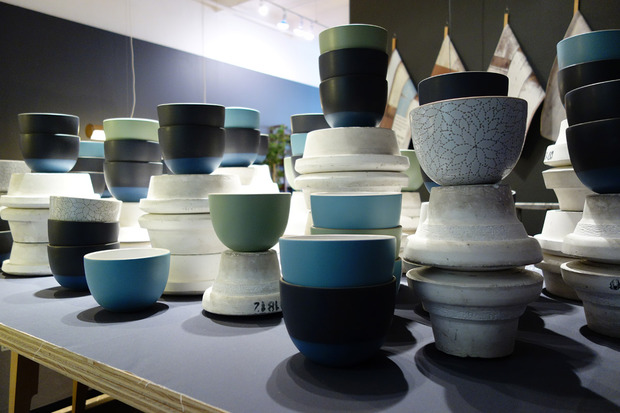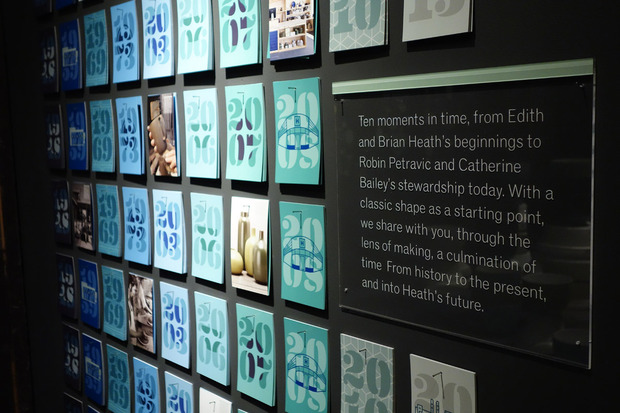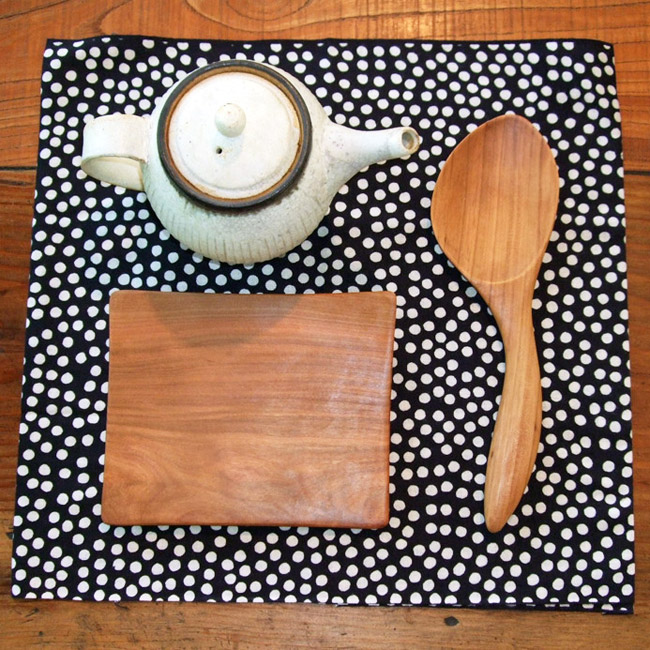Interview: Catherine Bailey of Heath Ceramics
The historic California pottery company showcased at The Future Perfect


Ten years ago Catherine Bailey’s interest in lending a design hand to the small but established California pottery company Heath Ceramics took a detour that resulted in Bailey and her husband serendipitously buying the Sausalito-based company. The twosome set to reviving and preserving Heath’s heritage—founded by Edith Heath in 1948—by creating a flagship store in LA and transforming their San Francisco location into fully functional tile factory, store and creative campus, which is now home to a demonstration kitchen and Blue Bottle Coffee bar. Though Bailey tells us they make decisions slowly and take things step-by-step, their prolific output over the past decade has been nothing short of inspirational. Events at Heath in Northern California and LA are filled with a jovial mix of customers, artists and collaborators.
To celebrate a new era of Heath, while still honoring its legacy, NYC’s The Future Perfect is showcasing the swoon-worthy ceramics in a display at their NoHo shop during the NYCxDesign. To glean a little insight into what the past 10 years have involved, we checked in with Bailey, who reflects on Heath’s past, present and future.
What originally inspired you to buy Heath Ceramics 10 years ago?
The most exciting thing to us initially was the holistic nature of what was going on under one roof. Designing and making was all happening in one place. There is also the factory store here, so even a little bit of selling. From our past experience, it was a frustration when we could not talk to the people who were making things or did not know who was selling them. So at Heath that was really inspiring.
How did purchasing the company come about?
That was a leap of faith. Nothing is going to happen if you don’t ask. You could tell physically that the company was in trouble. Everything was kind of a mess, dirty and dusty and there were not a lot of people around. It was really wonderful design in the past. At that moment in 2002 you could not tell what the past was. I thought I would approach them to see if they needed some design help. We quickly learned in the conversation that wasn’t an option. The company was going to close unless it found a buyer. So I switched gears to figure out how to buy it. It was Robin who had more confidence than I did. It was one step at a time, and the next thing we knew, it was all working out. We were amazed.

How would you describe the Heath design aesthetic?
The word I use the most is “classic.” The shapes are the essence of what they are intended to be. The coupe line, which is still what most people think of as Heath, has that plate in the essence of a plate. It is so pure and simple that is has become classic. It goes beyond the aesthetic and the feel and the fact that it looks durable. It is not precious. It looks like clay and glaze. All of that comes together to make something that’s obvious about what it is. It has craft in it. It is not mass-produced. It is all very honest. Material-driven. Classic. Simple.
How do you decide which artists and products to add to the legacy pieces?
It starts with shared philosophies and a shared aesthetic. When that starts to come together, you know you’ve got something good. We usually choose to work with people we already have a relationship with. We are friends. We love what they do. We love what they represent.
Why do you think you have done so many shows and collaborations with Japanese artists?
They fit together really beautifully. There is that certain Japanese aesthetic that is very in sync with Heath. Adam Silverman has always been inspired by Japanese pottery. He has some great relationships in Japan and has honed in on ones that are especially good fits. We do a yearly show with a Japanese potter named Akio Nukaga. His work doesn’t looks anything like Heath, but it’s got the same philosophy—it is very much about the material. If you meet Akio, he is a very humble potter who feels he does very functional work with a small amount of decoration.
How did Adam Silverman’s relationship with Heath come about?
We met Adam about the same time that we bought Heath. I admired his work. His background as an architect turning to be a potter—I found that to be fascinating. We became friends and we were trying to figure out what we should do together. We had lots of ideas, but we landed on that we wanted to do something in LA. We decided to move his studio into the store. It will give our store a sense of purpose and connect it to the LA community. It gave him a platform he could explore with merging some stuff with Heath and allowed him to keep pursuing his own work. He also curates what we have up here and other artists we work with.

What is going to be on view at The Future Perfect for the Heath 10 display?
We shipped a bunch of molds to New York. Those molds are the platform and foundation for showing some finished product. It’s that kind of merging, the essence of how we make a finished object. We have also created a graphical wall to highlight 10 moments in time of our history from the beginning to the present. It is a wall of one hundred postcards. There are ten different postcards that are repeated and they are things that people can take away and get a little deeper in with and understand about this journey of 1948 to 2013. There is consistency but also different eras that the company has traveled through. We try to bring that story out in the display.
What does the exclusive New York Bowl look like?
It’s a classic deep serving bowl. It was designed in 1948. To me, it is the essence of the perfect bowl. The way it fits in your hand. Its presence. It is big enough to be a statement. We have taken that bowl and used our new summer palette of glazes. The New York Bowl has two blue glazes; one dipped over the other that creates a graphic line. Those two glazes react to each other and create a texture. Picking up that bowl you learn about the essence of Heath.

What have you learned during the past 10 years?
We have gained the confidence to follow our gut feelings, the things that we love, and what feels right. In the beginning we were given a lot of advice. People told us this “isn’t going to work,” “you can’t do things this way,” or “you have to figure out what people want.” We just wanted to make things that we love. We thought other people would love them. We do things slowly, one step at a time; to be comfortable with that step before we take the next step. We need to trust why we are doing what we are doing and what makes it special.
What’s next?
For the rest of this year we are going to continue to celebrate the 10 years. Towards the end of the year we are going to bring Heath 10 back to the West Coast. We are making some clocks to celebrate this moment in time. We are doing clock collaborations with some of the people we have worked with before. We will have events in San Francisco and Los Angeles. Then early next Spring we have another clock that will be more of a production clock with House Industries—who we love working with too. They are very graphical, so it makes sense to do a clock with them. For Robin and I, we have a lot more to do in the San Francisco facility. We have a whole side of the building that we are developing into a creative campus. We want to do something with food. We have a Blue Bottle Coffee bar there now, but we have the space to do something more restaurant-like. Food brings people together. It will be a fun project.
What do you think Edith Heath would think about all this?
This year I am working on the studio space in San Francisco. I think she would have loved that. We will have a new studio director—kind of like how we work with Adam in Los Angeles—but this is more internal. It’s the studio where we will work to develop new ideas and shapes. We never had that space in Sausalito. I think Edith just went out on the factory and said, “It’s my factory move over I am going to do something here.” Now we have a real studio and a place to think and work in clay and develop ideas.
Images by Karen Day











